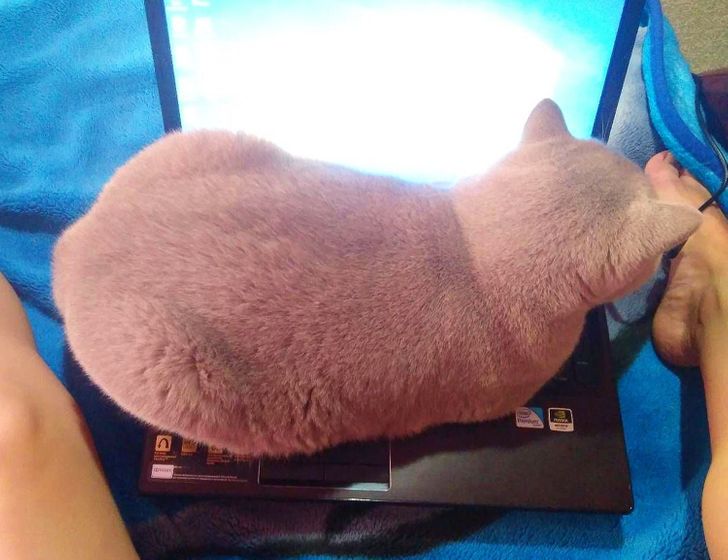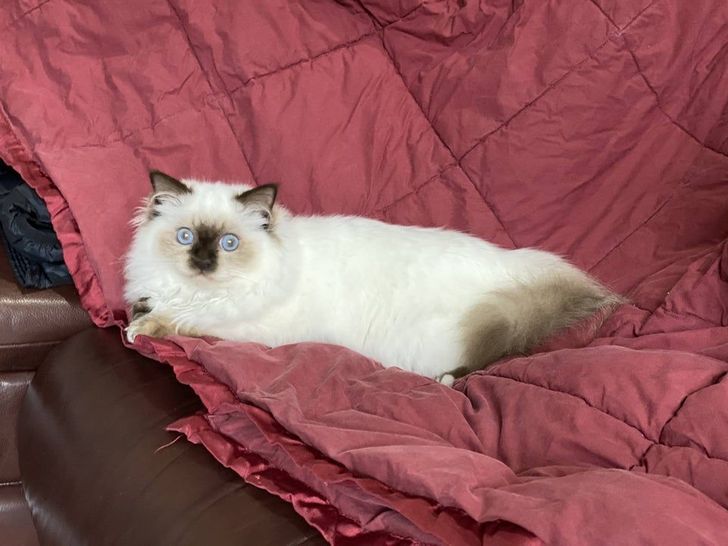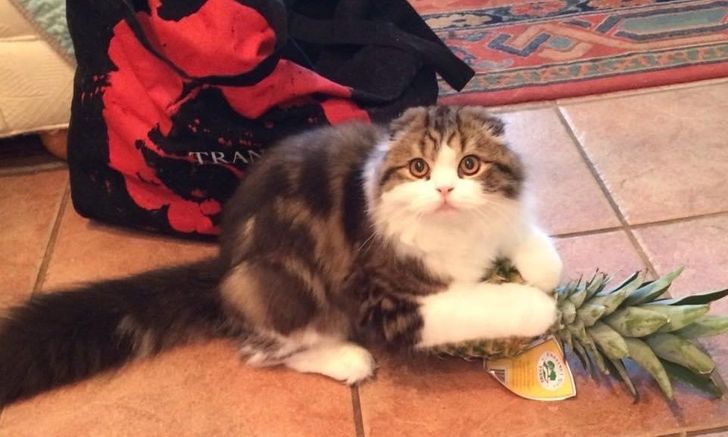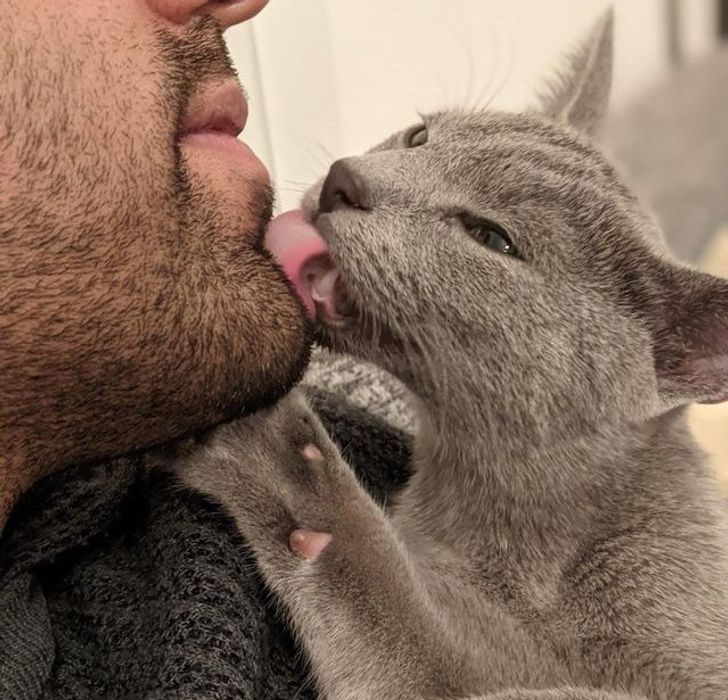😂😂✌️☺️
10 Cat Breeds That Can Cause Unexpected Problems for Their Owners

“Let’s get a kitten! Look how cute it is!” Many people follow an impulse after seeing the photos of cute fluffy cats and make a decision to adopt a pet. They believe that it will always stay this tiny and harmless. But when cats grow up they may cause some problems — some cats require regular brushing, some need warm clothes, and others scratch wallpaper. And some cats may even need to be walked outside.
At Bright Side, we decided to figure out what unexpected problems cat owners can experience because we understand that a pet at home is a huge responsibility.
1. The Sphynx
Sphynx cats are especially attractive to those allergic to fur. But you have to know that these cats are not totally hypoallergenic. And despite the fact that many people find the look of a Sphynx cat to be quite weird, this breed is famous for being gentle, friendly, and loyal.
When adopting a Sphynx cat, you should remember that it will require you to care for it, as if it were a new baby. “We all have health problems (humans and cats). But some are more avoidable by knowing you are dealing with a responsible breeder. Sphynx cats in general are more expensive to maintain than normal furry cats, this is due to the need for yearly HCM scanning by a licensed veterinarian cardiologist. Some commonly known Sphynx health issues are infectious diseases, cat eye issues, and disorders of the teeth and gums. Most all Sphynx cats also need a special diet,” one internet user said in an online discussion.
Besides, it can also be unexpected for many that Sphynx cats actually sweat.
- When my cat goes to sleep she also wakes up with yellow spots under her arms. You know, those warm wrinkles sweat throughout the night when she sleeps next to the heater. I used to bathe my cat every day, now I’m doing it less often, but it’s still 3 times a week or so. Sometimes I put a sweater on her so the yellow spots will be on the sweater the next day. © Wahlupa / Reddit
2. The Persian
Persian cats are smart, calm, and silent. If they need something, they won’t be meowing, they’ll just sit next to you and wait. They love to be petted and get attached to the family they live with. But you should be careful when leaving this cat alone with children, especially small and noisy ones. This breed is great for living in an apartment: your curtains and wallpaper will be safe.
“My wife loves this breed for some reason. I think it’s all about the way they look in photos. They look really funny and their photos get a lot of likes online. But otherwise, these cats are very problematic and demanding pets. My wife is responsible for cleaning all the fur up in our apartment. But I have to cover the costs of the food and vet visits, and they are pretty high. And I wouldn’t call our cat’s temper nice,” a member of an online discussion shared.
"The problem is that she hates hugs!"
“Persian cats are beautiful, affectionate, and calm. They are good for people who want to have a quiet pet, without wild jumping or a violent temper. Their disadvantages are mainly related to the care of their fur. It has to be brushed every day. Otherwise, their fur becomes really matted. You should start brushing a Persian cat from a very young age. Besides, Persian cats have a shortened nasolacrimal canal, which can lead to eye problems and constant tearing. They often have various allergies to both food and medication. You’ll also have problems with fur all over your apartment. It will be on your clothes and furniture, but it will also just be in the air. However, if you clean your apartment regularly, it won’t be a big problem. Besides, it’s much easier to get rid of long hair than short hair,” an internet user said.
3. The Birman
They are smart, active, and beautiful. Also, many owners mention their eyes being an unusual blue color. They are also peaceful and sociable. But if you decide to adopt a cat of this breed, you have to be prepared for frequent cleaning.
"Marshmallow is testing out the freshly washed blanket."
“This cat sheds terribly, we brush it every 2 days, but it continues to shed immediately after brushing. We asked our vet about it — they said that the problem is related to its age and will pass over time. But it’s barely possible to live with it because the fur is everywhere: in our food, on our clean dishes, on our toothbrushes, on our linens (even washed), on our face, in our nose, in our mouth, everywhere.”
“This girl had a checkup for her heart condition and received a good report from her cardiologist. No meds needed at this time.”
Also, experts mention that the health of this breed is quite fragile. Your house shouldn’t be drafty, the cat shouldn’t go outside during the cold season, and you should brush its fur regularly and take care of its teeth. To avoid behavioral problems, you have to play with it. This will support its natural hunting instincts.
4. The Turkish Angora
The Turkish Angora can become a great friend. These fluffy cats are monogamous, and they can’t be alone for a long time, so they’ll become an excellent companion for lonely people. They are sociable and like to play. But they let you pet them only when they want it, completely ignoring your desires.
"My beloved assistant"
These cats are quite active and require a lot of attention. Before you decide to adopt a kitten, you should understand whether you’ll have enough time to dedicate to your pet.
“I have a Turkish Angora. His name is Martin. He has blue eyes, snow-white fur, and he’s deaf. But this is not a problem at all! He’s been our favorite for 5 years now. He’s kind and affectionate only with me and my mother. As for other family members, he just tolerates them and makes it quite clear how he feels. He behaves like a real Turkish sultan. Our house belongs to him, and we are his slaves,” Martin’s owner says.
But the risk of becoming the owner of a cat with an ill temper is also high. “We had a cat of this breed. His name was Max. He lived for 18 years. He hated almost everyone, especially strangers, he would hiss and bite. It is because of him, that I don’t like cats.”
5. The Munchkin
These cute cats are the feline equivalent of the Dachshund because they have short legs and a long spine. And they don’t create many problems with the proper care. From an early age, you should brush their fur, bathe them when necessary, and watch their diet. Also, you shouldn’t be deceived by their look. Despite the fact that their legs are short, these cats are very fast and agile. “They are really good at jumping and running. Although their legs are short, they are really muscular, and that compensates for their lack of length. I have a Munchkin and a normal cat, and the Munchkin jumps higher,” one owner shared.
“Our family got a new member really spontaneously. My husband showed me a funny picture once, and I got curious about what these cats were and how they could even exist. I couldn’t fall asleep one night, and found a photo of our future cat online. He was no longer a kitten, and was sold for a token fee. The next day, he arrived at our house. He was 2.5 years old. His previous owners said that he was neutered and hated kids, that’s why they decided to find a new home for him. Our loving family became his new home,” one cat owner said.
6. The British Shorthair

"I became the owner of a British Shorthair 5 years ago. This cat can hardly be called problematic. All my life we’ve had pets in our house: both cats and dogs. My husband and I were not the cat’s first family. First, he lived at the breeder’s, of course, then he changed a few owners. As a result, when we came to take him, I immediately rushed to him, picked him up, and hugged him. The cat was a little shocked, but remained calm. The owner’s child got so scared, “Be careful! He’ll scratch you! You can’t hold him!” We had to spend quite a lot of time figuring out how to feed him. The ex-owner assured me that he “can eat anything, even potatoes and cucumbers.” But we had to go through several options of pet food and gave him meat in different variations, so that His British Highness would agree to take a bite.

He also didn’t allow us to pet him and didn’t want to sit on my lap. It took him some time to get used to us. First, he would just stay next to me for a while, but wouldn’t let me pet him. But this changed over time. Perhaps the reason was the second cat we got later that loved to sit on our laps. Now all my friends are amazed that I have such an affectionate and loving British Shorthair.
Only once he showed his true nature after my husband shouted at him. My husband found a surprise on his T-shirt that next morning. Also, if I behaved “badly,” the cat would scratch me, but this is a thing of the past now.

British Shorthairs are quite big cats and tend to gain weight. Therefore, the question of their diet should be taken seriously. To be honest, I can’t understand his previous owners at all. Perhaps they didn’t like cat hair in their home? This is true, the cat needs regular brushing, and still I find a lot of hair all over my apartment, which is quite tiring."
7. The Scottish Fold
This breed captivates you with its look, because thanks to its big eyes and folded ears, even an adult cat looks like a kitten. They feel comfortable in an apartment and with a big family. Scottish Folds are not afraid of noise, and children don’t bother them. They like to be petted, but don’t tend to be lap cats.
Tatiana’s experience proves this fact. “They love hands, but only they decide when to come to you and let you pet them. Our cat wakes up, eats, jumps on our lap (she decides whose lap it will be), lets us pet her neck and tummy, then watches TV for a couple of minutes, jumps down, and goes about her business. She doesn’t allow anyone to hold her any longer than she wants. Only I’m allowed to scratch her tummy.”
“Zaya grabs the pineapple out of the bag whenever I come home with one from the grocery store. She bites it, kicks it, and then sits on it!”
“It’s not true that Scottish Fold cats are angelic. At least, not all of them. Each case is different. When our Martin grew up, he became a real rascal — he hunted our feet all the time and scratched wallpaper. And he began to poo on the floor, even though he used to do it in his litter box before. Nothing helped. We learned from our friends who are cat owners too, that many cats have this problem — they simply refuse to go to the litter box at a certain age. And Martin doesn’t like to sit on laps, excluding the moments when he wants it himself, and that happens really rarely. But we love him the way he is.”
8. The Abyssinian

Natasha has been living side-by-side with this red-haired beauty for a few years now, and she certainly has a lot of fun: “Abyssinian cats are incredibly beautiful and unusual creatures — they have shiny fur, big ears, and charming eyes with eyelashes. These cats are very active and require constant attention. They love to be close to their owner (although, it’s arguable who owns who). You can touch and pet them only if they allow it.
You need to choose a breeder carefully: the health and temper of the pet depend on their responsibility and care.
As for their health:
- Abyssinian cats often have joint problems. It’s necessary to take this into account and make sure there are soft floors in your house, meaning that they are covered with carpets or rugs. This will minimize the risk of injury during jumping (and these cats really love to jump).
- Cats of this breed can have allergies.
- Abyssinian cats don’t have an undercoat, and they can feel cold in the winter. But it’s also to their advantage. They don’t feel hot in summer, and there is less cat hair in the house.
Our cat also has chronic rhinitis, he got it from the breeder. This is the reason why you should require all certificates related to the kitten’s health when buying it.
Abyssinian cats are a little nervous, and this can lead to illnesses. Sometimes they are naughty. They can bite if they don’t like something. They are very determined if they want something (and they usually get it). They’ll hit you with a paw if they’re hungry, or scratch at a door until you open it.
In general, you fall in love with them immediately, they are very spontaneous, and not like other cats. However, any cat owner could say that about their pet.”

The Abyssinian’s stubbornness is mentioned by many owners, “At one moment, I began to think that we got a defective Abyssinian! In the articles I read, this breed was described as affectionate and docile. And our beauty is not like that at all. She has a very strong character — if she doesn’t want to do something, it’s useless to persuade her otherwise. She’s very playful, and can’t sit still. She won’t sit on your lap no matter what you do. Sometimes I think this is not a cat and not even a dog, but a donkey! She’s really stubborn!”
9. The Russian Blue
These cats are meek, quiet, calm, and they behave with dignity. But at the same time, they are independent and can show a strong character. They are quite easy to care for — the only problem can be their fur. You should think about buying or building a scratching post before getting a cat home. As soon as a kitten enters your home, it will need to sharpen its claws somewhere. If there is no dedicated place for it, it will sharpen its claws on your furniture and wallpaper.
The adaptation period can take some time, therefore, they take it hard during moving and other changes. Their trust needs to be earned too.
"Does anyone else's Russian Blue give the best kisses?"
Russian Blue cats have a thick and long undercoat. Therefore, they should be brushed once a week, and even more often during the shedding period. This breed is very sociable, and Anna confirms it: “I have a cat, Milo, who is extremely talkative. He closes his mouth only when he sleeps. After having read the stories of other Russian Blue owners, I realized that this is a common feature of this breed.” At the same time, they don’t like noise, so there always should be a cozy place where this cat can hide when you have guests over. If the owners are loud and have frequent guests, the pet can become nervous and fearful.
"Mei regrets nothing!"
Russian blue cats love to hunt. So if the owners decide to also have a parrot or hamster, then they should watch their cage.
10. The Norwegian Forest cat
These Viking cats, as they are sometimes called, are friendly and gentle. If you are a family with children, you don’t have to worry: the Norwegian Forest cats get along with them well and won’t hurt them. The cat will just walk away as a last resort.
Their beautiful and long fur should be frequently brushed. Otherwise, it’ll get tangled. Their diet is not an easy task either. You can’t feed them with just dry cat food and should use natural foods too. Unlike other cat breeds, Norwegian Forest cats are allowed to drink milk but only 1 to 2 times a week. They love it.
“These little monsters figured out how to open the closet to get their toys on the top shelf. Here they are acting innocent after they got caught.”
Due to its active mindset, a cat can cause some problems — if you don’t pay attention to it, it will smash everything around, jumping from one surface to another. “They are formidable climbers. Big thick claws and unusually strong leg muscles. I have 9 feet tall bookshelves in my apartment and a ladder that goes right to the top. Not a day goes by when my cat doesn’t take the opportunity to scale the ladder and walk along the top of the shelves,” an internet user says. So, it’s good if your apartment has a multi-level scratching post so that a forest cat can satisfy its instinctual needs.
Do you have a cat? What problems does it cause you? Tell us in the comments below.
Comments
that 2nd one stole my heart for sure
Related Reads
Australian Comedian Recreates Celebrity Pics, and People Call Her the “Queen of Comedy” for Her Uproarious Parodies

My Ex Put His New Family Over Our Son, So I Served Him the Sweetest Revenge

18 Stories That Prove a Cleaner’s Job Is About More Than Just Dusting

I Absolutely Refuse to Tolerate My DIL’s Laziness, My Son Deserves a Wife, Not a Freeloader

15 Fitting Room Stories That Can Make You See Shopping in a Whole New Light

My Husband Made Me Care for His Sick Mother, So I Served a Payback He Won’t Forget

10 Parents Whose Quiet Kindness Spoke Louder Than Words

I Refuse to Let My Father’s Secret Love Child Steal My Inheritance

I Refuse to Let the Former Owner Get Married in My Backyard—My Kindness Stops Here

I Was Excluded From a “Family” Dinner—My Revenge Taught My DIL a Lesson

11 True Stories That Prove Real Life Doesn’t Need a Screenplay

13 Times People Accidentally Uncovered Someone’s Biggest Secret


















